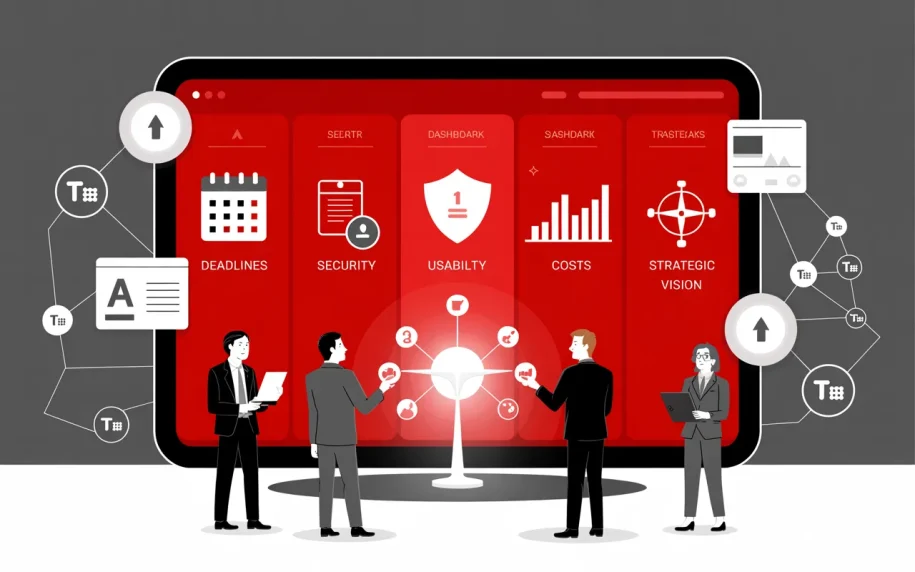Sommaire
- 1 Why these 5 questions matter
- 2 1) Deadlines: how are they generated, updated, and tracked?
- 3 2) Security & confidentiality: where is the data and how is it protected?
- 4 3) Ease of use & adoption: ergonomics make the difference
- 5 4) Real costs (TCO): subscription, migration, support, training… and avoiding fragmentation
- 6 5) Strategic vision & control: turning data into decisions
- 7 Conclusion
- 8 FAQ – Common Questions About Trademark Management Software
Why these 5 questions matter
For legal departments and counsel, a trademark (and domain name) portfolio is a strategic asset. Choosing software is not about convenience—it is a decision that reduces risks, improves control, and creates value. This guide provides a concrete method built around 5 essential questions that structure any informed decision.
1) Deadlines: how are they generated, updated, and tracked?
What to evaluate:
- Source of deadlines (automatic calculations, legal databases, multi-country harmonization).
- Centralization (a single calendar for all trademarks, files, and territories).
- Traceability (who created/modified a deadline, when, with what reminders).
- Readability (filters, priority views, color codes).
- Interoperability (links between deadlines, cases, trademarks, domains, invoicing).
Why it’s critical:
Missing a renewal, opposition, or affidavit means high costs or loss of rights. The software must lock down this risk through strong automation and consolidation.
Example – IPzen:
IPzen offers an Agenda & Deadline Tracking Module that centralizes all deadlines (system-generated or user-defined), provides flexible reminders, priority filters, and collaborative access. It also calculates renewals/affidavits automatically and uses color-coded statuses (active, partial protection, dispute, etc.) for clarity.
Demo questions to ask:
- Show me an automatically calculated renewal and the applied rule.
- Let’s filter deadlines 90 days ahead—what do I see, how do I escalate?
- Where’s the proof of traceability (creation/modification/notification logs)?
2) Security & confidentiality: where is the data and how is it protected?
What to evaluate:
- Hosting model (private/dedicated cloud vs shared).
- Data encryption (at rest and in transit).
- Client isolation (multi-tenant vs dedicated VM).
- Backups and redundancy (frequency, locations, recovery).
- 24/7 monitoring, incident management, logging.
- Contractual clauses: SLA, liability, data retention/exit.
Example – IPzen:
Private cloud hosting with encrypted VM per client, SSL 256-bit encryption, backups every 15 minutes in Paris & Amsterdam datacenters, 24/7 monitoring.
Due diligence to request:
- Written proof of technical measures (encryption, VM isolation).
- Backup/restore policy (RPO/RTO) and hosting locations.
- Example logs and incident alert procedures.
3) Ease of use & adoption: ergonomics make the difference
What to evaluate:
- Learning curve: intuitive dashboard, filters, search.
- Multi-criteria search (country, classes, dates, statuses).
- Business views (upcoming deadlines, portfolios by BU/country, disputes, oppositions).
- Consistent labels and color codes.
- Integrated document management (templates, versions, links to files/trademarks).
Example – IPzen:
Customizable dashboard, multi-criteria search (expiration dates, classes, zones), and color codes for instant portfolio status.
Document management includes secure cloud-based file handling, templates, and collaboration.
Demo questions to ask:
- Search: “All class 35 trademarks expiring in 180 days in the EU.”
- Dashboard: risk view (disputes/oppositions) + renewals view.
- Documents: generate a template letter/report linked to a trademark.
4) Real costs (TCO): subscription, migration, support, training… and avoiding fragmentation
What to evaluate:
- Subscription (per user, per volume, per module).
- Data migration (scope, quality, historical data).
- Support & training (included? scalable?).
- Optional modules (invoicing, domain monitoring), to avoid fragmentation and hidden costs.
- Exit terms (export completeness, formats, costs).
Example – IPzen:
An integrated invoicing module (optional): one-click invoices (linked to trademark data), multi-case consolidation, client profiles, reminders, and financial dashboards. This avoids the need for separate invoicing tools and keeps everything unified.
Clarifications to request:
- Pricing model by scope (users, trademarks, modules).
- Migration plan (extraction, cleaning, import, validation).
- End-of-contract export (formats, completeness, reversibility).
5) Strategic vision & control: turning data into decisions
What to evaluate:
- Dashboards: views by risks, budgets, regions/BUs.
- Reports: renewals in 90/180/365 days, unused marks, disputes, oppositions.
- Multi-criteria searches and visual statuses for prioritization.
- Links with domain names and technical parameters (digital presence).
Example – IPzen:
Real-time dashboards, searches, and monitoring (statuses, renewals, infringements).
Domain name management includes TLD availability checks, renewal deadlines, country filters, DNS/zone management, exports, and invoicing directly within the system.
Conclusion
Choosing trademark management software is a structural decision for legal departments. It is not just about usability or price—it impacts the security of intangible assets, operational efficiency, and the ability to prove the strategic value of trademarks to executives.
By asking these 5 essential questions—about deadlines, security, usability, costs, and strategic vision—you ensure you select a solution that does more than store data: it helps transform your portfolio into a lever of sustainable competitiveness.
The right software is not the one with the most features, but the one that brings reliability, peace of mind, and visibility.
FAQ – Common Questions About Trademark Management Software
- Can trademark software fully replace Excel?
Yes. Unlike Excel, dedicated software automates deadline calculations, logs actions, and drastically reduces risk. - What are the main risks of manual tracking?
Missed renewals, loss of rights, avoidable disputes, and lack of visibility for management. - How can I convince executives to invest?
By showing that intellectual property is a strategic asset. Software protects it, reduces risks, and generates clear reports for decision-making. - Do these solutions require long training?
No, if well-designed. Modern solutions focus on intuitive dashboards and easy adoption. - Do they also cover domain names?
Some do, like IPzen, which integrates a dedicated module. This ensures consistency between trademarks and domains and strengthens online monitoring.


